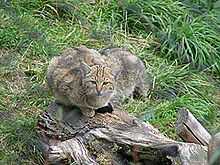List of mammals of Iraq
This is a list of the mammal species recorded in Iraq. There are 78 mammal species in Iraq, of which 0 are critically endangered, 1 is endangered, 11 are vulnerable, and 3 are near-threatened. 1 of the species listed for Iraq can no longer be found in the wild.[1]
The following tags are used to highlight each species' conservation status as assessed by the IUCN:
| EX | Extinct | No reasonable doubt that the last individual has died. |
| EW | Extinct in the wild | Known only to survive in captivity or as a naturalized populations well outside its previous range. |
| CR | Critically Endangered | The species is in imminent risk of extinction in the wild. |
| EN | Endangered | The species is facing an extremely high risk of extinction in the wild. |
| VU | Vulnerable | The species is facing a high risk of extinction in the wild. |
| NT | Near Threatened | The species does not meet any of the criteria that would categorise it as risking extinction but it is likely to do so in the future. |
| LC | Least Concern | There are no current identifiable risks to the species. |
| DD | Data Deficient | There is inadequate information to make an assessment of the risks to this species. |
Some species were assessed using an earlier set of criteria. Species assessed using this system have the following instead of Near Threatened and Least Concern categories:
| LR/cd | Lower Risk/conservation dependent | Species which were the focus of conservation programmes and may have moved into a higher risk category if that programme was discontinued. |
| LR/nt | Lower Risk/near threatened | Species which are close to being classified as Vulnerable but are not the subject of conservation programmes. |
| LR/lc | Lower Risk/least concern | Species for which there are no identifiable risks. |
Subclass: Theria
Infraclass: Eutheria
Order: Sirenia (manatees and dugongs)
Sirenia is an order of fully aquatic, herbivorous mammals that inhabit rivers, estuaries, coastal marine waters, swamps, and marine wetlands. All four species are endangered.
- Family: Dugongidae
Order: Rodentia (rodents)
Rodents make up the largest order of mammals, with over 40 percent of mammalian species. They have two incisors in the upper and lower jaw which grow continually and must be keep short by gnawing. Most rodents are small though the capybara can weigh up to 45 kg (100 lb).
- Suborder: Sciurognathi
- Family: Sciuridae (squirrels)
- Family: Gliridae (dormice)
- Subfamily: Leithiinae
- Genus: Dryomys
- Forest dormouse Dryomys nitedula LR/nt
- Genus: Eliomys
- Asian Garden Dormouse Eliomys melanurus LC
- Genus: Dryomys
- Subfamily: Leithiinae
- Family: Dipodidae (jerboas)
- Subfamily: Allactaginae
- Genus: Allactaga
- Euphrates Jerboa Allactaga euphratica LR/nt
- Genus: Allactaga
- Subfamily: Allactaginae
- Family: Spalacidae
- Subfamily: Spalacinae
- Genus: Nannospalax
- Palestine Mole Rat Nannospalax ehrenbergi LC
- Genus: Nannospalax
- Subfamily: Spalacinae
- Family: Cricetidae
- Subfamily: Cricetinae
- Genus: Cricetulus
- Gray Dwarf Hamster Cricetulus migratorius LR/nt
- Genus: Mesocricetus
- Turkish hamster Mesocricetus brandti LR/lc
- Genus: Cricetulus
- Subfamily: Arvicolinae
- Genus: Microtus
- Günther's Vole Microtus guentheri LR/nt
- Persian Vole Microtus irani LR/lc
- Genus: Microtus
- Subfamily: Cricetinae
- Family: Muridae (mice, rats, voles, gerbils, hamsters, etc.)
- Subfamily: Deomyinae
- Genus: Acomys
- Cairo Spiny Mouse Acomys cahirinus LC
- Genus: Acomys
- Subfamily: Gerbillinae
- Genus: Gerbillus
- Cheesman's Gerbil Gerbillus cheesmani LR/lc
- Wagner's Gerbil Gerbillus dasyurus LR/lc
- Gerbillus mesopotamiae LR/lc
- Gerbillus nanus LC
- Genus: Meriones
- Sundevall's Jird Meriones crassus LC
- Libyan Jird Meriones libycus LC
- Persian Jird Meriones persicus LR/lc
- Tristram's Jird Meriones tristrami LR/lc
- Genus: Tatera
- Indian Gerbil Tatera indica LR/lc
- Genus: Gerbillus
- Subfamily: Murinae
- Subfamily: Deomyinae
Order: Lagomorpha (lagomorphs)

The lagomorphs comprise two families, Leporidae (hares and rabbits), and Ochotonidae (pikas). Though they can resemble rodents, and were classified as a superfamily in that order until the early 20th century, they have since been considered a separate order. They differ from rodents in a number of physical characteristics, such as having four incisors in the upper jaw rather than two.
- Family: Leporidae (rabbits, hares)
- Genus: Lepus
- Cape Hare Lepus capensis LR/lc
- European Hare Lepus europaeus LR/lc
- Genus: Lepus
Order: Erinaceomorpha (hedgehogs and gymnures)
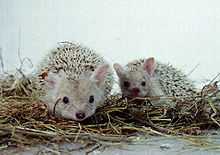
The order Erinaceomorpha contains a single family, Erinaceidae, which comprise the hedgehogs and gymnures. The hedgehogs are easily recognised by their spines while gymnures look more like large rats.
- Family: Erinaceidae (hedgehogs)
- Subfamily: Erinaceinae
- Genus: Hemiechinus
- Desert Hedgehog Hemiechinus aethiopicus LR/lc
- Long-eared Hedgehog Hemiechinus auritus LR/lc
- Genus: Hemiechinus
- Subfamily: Erinaceinae
Order: Soricomorpha (shrews, moles, and solenodons)
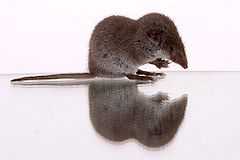
The "shrew-forms" are insectivorous mammals. The shrews and solenodons closely resemble mice while the moles are stout-bodied burrowers.
- Family: Soricidae (shrews)
- Subfamily: Crocidurinae
- Genus: Crocidura
- Bicolored Shrew Crocidura leucodon LR/lc
- Lesser White-toothed Shrew Crocidura suaveolens LR/lc
- Genus: Crocidura
- Subfamily: Crocidurinae
Order: Chiroptera (bats)
The bats' most distinguishing feature is that their forelimbs are developed as wings, making them the only mammals in the world naturally capable of flight. Bat species account for about 20% of all mammals.
- Family: Vespertilionidae
- Subfamily: Myotinae
- Genus: Myotis
- Lesser Mouse-eared Bat Myotis blythii LR/lc
- Long-fingered Bat Myotis capaccinii VU
- Natterer's bat Myotis nattereri LR/lc
- Genus: Myotis
- Subfamily: Vespertilioninae
- Genus: Eptesicus
- Botta's Serotine Eptesicus bottae LC
- Sind Bat Eptesicus nasutus VU
- Northern Bat Eptesicus nilssoni LR/lc
- Genus: Otonycteris
- Desert Long-eared Bat Otonycteris hemprichii LR/lc
- Genus: Pipistrellus
- Kuhl's Pipistrelle Pipistrellus kuhlii LC
- Rüppel's Pipistrelle Pipistrellus rueppelli LC
- Genus: Eptesicus
- Subfamily: Miniopterinae
- Genus: Miniopterus
- Schreiber's Long-fingered Bat Miniopterus schreibersii LC
- Genus: Miniopterus
- Subfamily: Myotinae
- Family: Rhinopomatidae
- Genus: Rhinopoma
- Lesser Mouse-tailed Bat Rhinopoma hardwickei LC
- Greater Mouse-tailed Bat Rhinopoma microphyllum LC
- Genus: Rhinopoma
- Family: Molossidae
- Genus: Tadarida
- European Free-tailed Bat Tadarida teniotis LR/lc
- Genus: Tadarida
- Family: Rhinolophidae
- Subfamily: Rhinolophinae
- Genus: Rhinolophus
- Mediterranean Horseshoe Bat Rhinolophus euryale VU
- Greater Horseshoe Bat Rhinolophus ferrumequinum LR/nt
- Lesser horseshoe bat Rhinolophus hipposideros LC
- Mehely's Horseshoe Bat Rhinolophus mehelyi VU
- Genus: Rhinolophus
- Subfamily: Rhinolophinae
Order: Cetacea (whales)


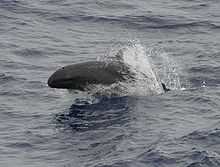
The order Cetacea includes whales, dolphins and porpoises. They are the mammals most fully adapted to aquatic life with a spindle-shaped nearly hairless body, protected by a thick layer of blubber, and forelimbs and tail modified to provide propulsion underwater.
- Suborder: Mysticeti
- Family: Balaenopteridae
- Subfamily: Balaenopterinae
- Genus: Balaenoptera
- Bryde's Whale Balaenoptera edeni DD
- Genus: Balaenoptera
- Subfamily: Megapterinae
- Genus: Megaptera
- Humpback Whale Megaptera novaeangliae VU
- Genus: Megaptera
- Subfamily: Balaenopterinae
- Family: Balaenopteridae
- Suborder: Odontoceti
- Superfamily: Platanistoidea
- Family: Phocoenidae
- Genus: Neophocaena
- Finless Porpoise Neophocaena phocaenoides DD
- Genus: Neophocaena
- Family: Delphinidae (marine dolphins)
- Genus: Sousa
- Sousa chinensis DD
- Genus: Grampus
- Risso's Dolphin Grampus griseus DD
- Genus: Pseudorca
- False Killer Whale Pseudorca crassidens LR/lc
- Genus: Sousa
- Family: Phocoenidae
- Superfamily: Platanistoidea
Order: Carnivora (carnivorans)
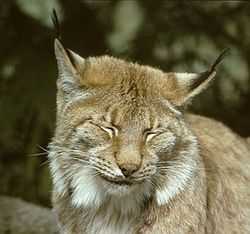
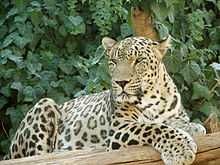

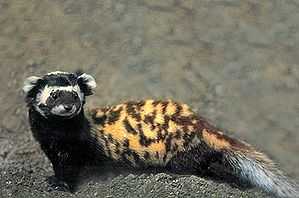
There are over 260 species of carnivorans, the majority of which feed primarily on meat. They have a characteristic skull shape and dentition.
- Suborder: Feliformia
- Family: Felidae (cats)
- Subfamily: Felinae
- Subfamily: Pantherinae
- Genus: Panthera
- Asiatic Lion Panthera leo persica EN
- Persian Leopard Panthera pardus ciscaucasica EN
- Caspian Tiger Panthera tigris virgata EX
- Genus: Panthera
- Family: Hyaenidae (hyaenas)
- Genus: Hyaena
- Striped Hyena Hyaena hyaena LR/nt
- Genus: Hyaena
- Family: Felidae (cats)
- Suborder: Caniformia
- Family: Canidae (dogs, foxes)
- Genus: Vulpes
- Red Fox Vulpes vulpes LC
- Ruppell's FoxVulpes rueppelli DD
- Golden Jackal Canis aureus LC
- Gray Wolf Canis lupus LC
- Genus: Vulpes
- Family: Ursidae (bears)
- Genus: Ursus
- Brown Bear Ursus arctos LR/lc
- Genus: Ursus
- Family: Mustelidae (mustelids)
- Family: Canidae (dogs, foxes)
Order: Artiodactyla (even-toed ungulates)
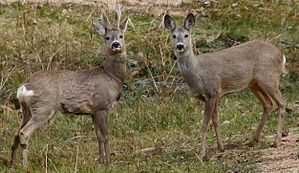
The even-toed ungulates are ungulates whose weight is borne about equally by the third and fourth toes, rather than mostly or entirely by the third as in perissodactyls. There are about 220 artiodactyl species, including many that are of great economic importance to humans.
- Family: Cervidae (deer)
- Subfamily: Cervinae
- Genus: Dama
- Fallow Deer Dama dama LR/lc
- Dama mesopotamica (Mesopotamian Fallow Deer) EW
- Genus: Dama
- Subfamily: Capreolinae
- Genus: Capreolus
- Roe Deer Capreolus capreolus LR/lc
- Genus: Capreolus
- Subfamily: Cervinae
- Family: Bovidae (cattle, antelope, sheep, goats)
- Subfamily: Antilopinae
- Genus: Gazella
- Water Buffalo Buffalo Water FB
- Saudi Gazelle Gazella saudiya EW
- Goitered Gazelle Gazella subgutturosa VU
- Genus: Gazella
- Subfamily: Caprinae
- Genus: Capra
- Wild Goat Capra aegagrus VU
- Genus: Capra
- Subfamily: Hippotraginae
- Genus: Oryx
- Arabian Oryx Oryx leucoryx EN
- Genus: Oryx
- Subfamily: Antilopinae
- Family: Suidae (pigs)
Notes
- ↑ This list is derived from the IUCN Red List which lists species of mammals and includes those mammals that have recently been classified as extinct (since 1500 AD). The taxonomy and naming of the individual species is based on those used in existing Wikipedia articles as of 21 May 2007 and supplemented by the common names and taxonomy from the IUCN, Smithsonian Institution, or University of Michigan where no Wikipedia article was available.
References
- "?". IUCN. 2001. Retrieved 22 May 2007.
- "Mammal Species of the World". Smithsonian National Museum of Natural History. 2005. Archived from the original on 27 April 2007. Retrieved 22 May 2007.
- "Animal Diversity Web". University of Michigan Museum of Zoology. 1995–2006. Retrieved 22 May 2007.
- Hatt, R. T. 1959 The mammals of Iraq. Museum of Zoology, Univ. of Michigan No. 106. http://hdl.handle.net/2027.42/56350
See also
- List of chordate orders
- List of regional mammals lists
- List of prehistoric mammals
- Mammal classification
- New mammal species
| ||||||||||||||

